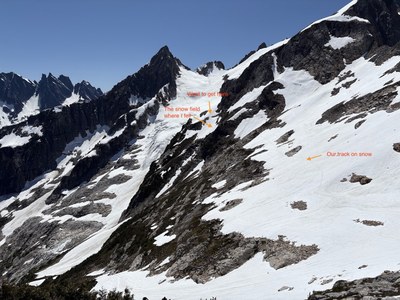
Trip Report
Mount Fury/Southeast Glacier (6/29/2025 Accident Report)
Disclaimer: This is a private trip and is an accident report. Posting here so it could be useful to future climbs of Fury. On 6/29/025, as my climbing partner and I approached Mt Fury from Luna Col in the Pickets range in North Cascades, I took a 120 feet fall on a steep snow slope and had to be rescued by a helicopter. Here are the details of this accident.
- Fri, Jun 27, 2025 — Sun, Jun 29, 2025
- Mount Fury/Southeast Glacier
- Climbing
- Turned Around
- Road suitable for all vehicles
We camped at Luna Col the night before after climbing Luna Peak. The plan for the day was to climb Mt Fury East Peak and possibly West Peak and camp on top of East Fury. We started around 6 AM. The climbing was slow going due to early season conditions, changing between rock and snow, route finding, and class 3-5 terrain with high exposures. It took us almost 5 hours to get to the top of the 3rd tower. Our original plan after Mt Fury was to traverse to South Pickets and exit from Goodell. As we got closer and had a good look at the whole traverse, it became clear to us that it was not going to work due to snow on climbing routes. We decided to exit by backtracking. Since there was no reason to camp on top of East Fury, we dropped some extra weight on top of tower 3. The revised plan was to go to Mt Fury and back. If time permitted, we would try West Fury.
We continued on and soon there was more and more snow. As we reached the snow slope we believed that connected to the glacier, we had to cross a moat to get on the snow. The snow was steep, about 50 degrees at the moat and about 40 to 45 degrees at the bottom. The snow was soft for kicking steps but also might have been a little too soft that steps could collapse under weight. My partner went on the snow first. As he complained about the steepness of the snow, I went on the snow from another spot. I first put my left leg on the snow and was sitting on the edge of the moat. When I swung the right leg over, the foot already on the snow started to slip given all my weight was on this single foot now. Soon I was gaining speed. I tried to self arrest but was unsuccessful due to the soft snow. I felt like it was only a second before I glimpsed the end of the snow and here came the rocks. Brace for impact was the last thought. I felt I was airborne and rotated a few times but somehow I stopped miraculously. The first thing that came to my mind was "I am alive!" The second thing was “where does it hurt?” My partner was yelling “are you ok?” I yelled back “give me a second” because I knew I needed to let things settle down before I could tell if I was ok. At that moment, I didn’t feel much pain probably because of the adrenaline rush. I moved my legs, feet, head, arms, etc. and seemed like everything moved fine without pain. Nothing was broken. What a relief! I needed to get back up to my partner. I wanted to first take off my campons to avoid tripping myself on the rocks while walking back up to the start of the snow. As I took my glove off to unstrap my crampon, I realized my left hand was covered in blood and blood was gushing out from a hole in the hand, probably an ice axe puncture wound. I didn’t do too much about it. Not my top worry. I unstrapped my crampons and walked up to the snow. At this moment the bleeding had stopped. I strapped my crampons on again and started kicking steps to climb up. It took quite a while to get up to my partner. During this time, blood started to drip on the snow due to the pressure from holding my pole. Near the top, I started to feel pain when I lifted my right leg. I sucked it up and went over the moat and on to the rocks. The fall happened around 12:30 PM.
We did some first aid treatment on my hand, which soon stopped bleeding again. We took a long rest, drank water, and ate food. Apparently, the only sensible option was to turn around. The question was whether we should call rescue. I wanted to give it a try and see how well I could walk and climb. Hopefully, we could get back to our stashed gear and make a decision there. The overall route back was not easy (class 3 and 4 snow, dirt, and rock) and it was painful every step lifted my right leg. It took us 2 hours to get to a ridge top where it was flat and we can see where we stashed our gear about 0.35 mile away. Here we had a discussion. I didn’t think I could safely go over some of the class 4 and 5 terrain over three towers and back to Luna Col. Even if I could, there was an additional two days hike back to the trailhead. At this moment, calling search and rescue was the obvious choice. I switched on SOS on my InReach at 3:34 PM and soon messages started to arrive. We got connected to the North Cascades National Park rangers. They asked a bunch of questions and sent in a helicopter. While we were waiting for the rescue, my partner went to our gear stash and carried them back to my spot. The helicopter arrived a little after 6 PM. They spotted us immediately since we were on the ridge top waving a sleeping bag. They circled around but couldn’t find a spot to land so they landed on a tiny flat spot on the next ridge about 1000 feet away. They sent two rangers over to check on me and discuss the plan. They suggested a short haul to move me over to their spot. Soon the operation was underway meticulously and I was on the way to Marblemount Ranger Station, which we arrived at probably around 7:30 PM. After some additional medical checks and paperwork at the ranger station, a ranger drove us back to the trailhead to pick our cars.
What went wrong and how can we improve?
In terms of decision making, we had two options that could have prevented this accident. An obvious option was to turn around. My partner also lost his crampons during the bushwacking down below on the second day of the approach. We thought the snow was soft enough even for just boots to kick steps. In hindsight, if there was no way to avoid this 50 degree steep snow traverse, it was probably not a good idea to continue since it would have been more dangerous coming down. However, summit fever might have clouded our judgment. The other option is to find a different route. After I was back, I looked at the picture and map again. We could have dropped further down to traverse on dry land instead of snow. However, it was hard to see in close proximity and because we were already behind in time, we didn’t think through the options.
In terms of technicality, a few things to call out. The snow condition that day was soft. It was easy to kick steps so I let my guard down when I did the maneuver of getting on the snow from the moat. Then, because it was soft, it became very difficult to arrest on steep snow because the pick of the ice axe just sliced through the snow instead of biting. In such conditions, it was steep enough that you would gain speed quickly and would not slow down as you would on a less steep soft snow, but at the same time, it was soft enough that self arrest wouldn’t work. Placing pickets probably also would not work well unless you place the pickets really deep into the snow to reach the hard layer.
What had worked in our favor?
Luck was definitely on my side that day but there were a few things to mention. (1) Even though I was not able to self arrest, I was trying very hard. In fact, the muscle under my left big thumb was severely bruised because I was holding the ice axe so hard trying to arrest the fall. However, I think the attempt still slowed me down a little bit. (2) I had a backpack on with a bunch of stuff like rope, climbing gear, food, etc., which worked as a cushion and reduced the impact. I had no cuts or bruises on my back. The backpack also provided additional friction on the rocks. (3) When I hit the rocks, I rolled instead of tomahawking or sliding. While it was not intentional, it reduced blunt force impact or abrasion. (4) The rock field I fell on were mostly smaller rocks vs large boulders. (5) I was so lucky that I stopped. If I had continued to fall 50 more feet, I would have dropped off a cliff. (6) The whole retreat and rescue operation worked out well thanks to my partner, the rangers, heli crew, and InReach operators.
Overview of the route:
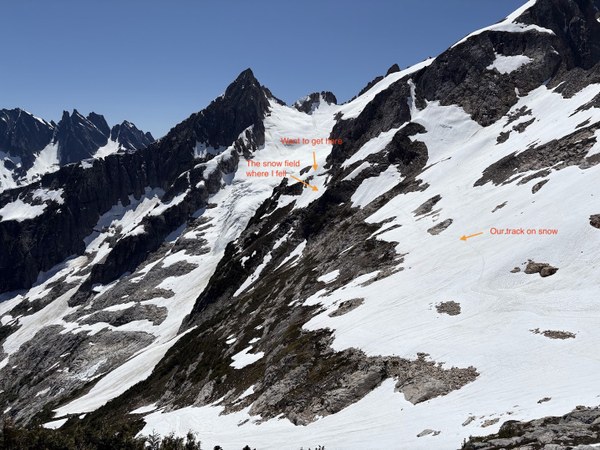
Close up view of the fall zone, our route, and possible alternative route (or further down below)
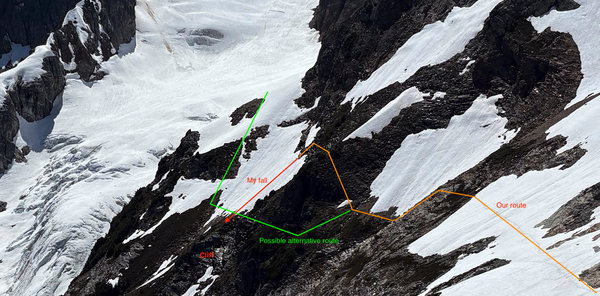
The slope I fell - starting to get back up
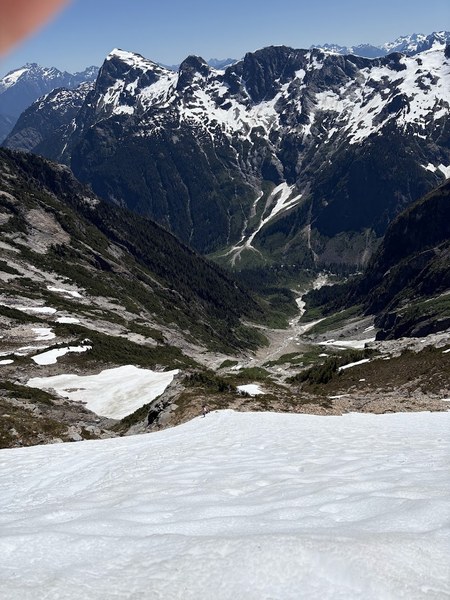
Slope angle of the fall zone
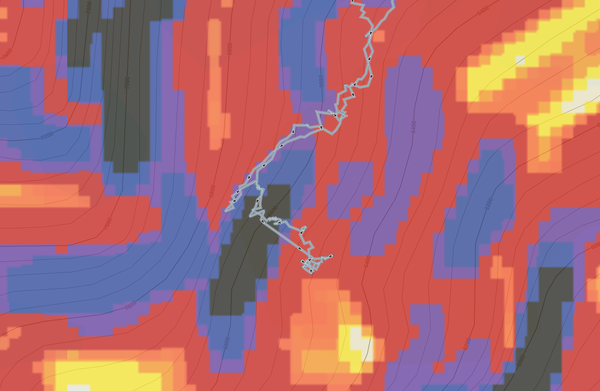
Retreat and rescue locations
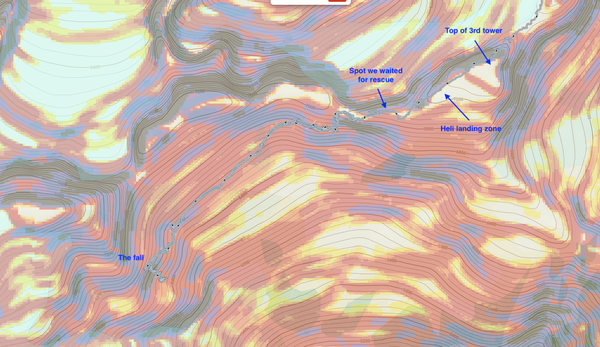
Heli short haul
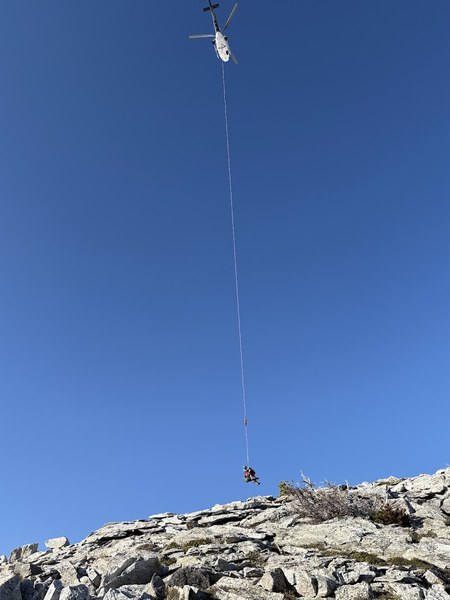
 Frank Chai
Frank Chai